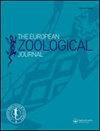Black kites wintering in Europe: estimated number, subspecies status, and behaviour of a bird wintering on Crete and Turkey
IF 1.6
4区 生物学
Q2 ZOOLOGY
引用次数: 0
Abstract
Abstract Black kites of the nominal subspecies Milvus migrans migrans breed in Europe and winter regularly in sub-Saharan Africa and the Middle East. As a new phenomenon, black kites with morphological characteristics of the subspecies Milvus migrans lineatus are observed in Europe. Based on observations of black kites in winter 2020/2021 summarized in this paper, based on other recent reports about wintering black kites in Europe and based on juvenile black kite tagged on Crete and tracked for two years, we conclude that hundreds to thousands of black kites are now regularly wintering in south of Europe, and in smaller numbers in other parts of Europe as well as in northern Africa. The growing number of wintering black kites in Europe is apparently caused by members of the population from a hybrid zone between M. m. migrans and M. m. lineatus breeding east of the Urals, i.e. from the area of the European part of Russia. This is consistent with the hypothesis of the spreading of M. m. lineatus and a subsequent hybridization zone between M. m. migrans and M. m. lineatus in a westerly direction from Siberia across continental Europe. Moreover, two black kites found dead on Crete were attributed to M. m. lineatus and M. m. migrans by cytochrome B gene sequence analyses. The juvenile black kite with lineatus features tagged on Crete and telemetrically tracked during the next two years moved to the south-western part of Russia during the next two summers, but did not breed. It spent the following two winters at the same landfill in south-western Turkey. It seems that an adaptation to food sources provided by municipal waste landfills is important for black kites wintering in Europe, the Middle East and Morocco. Highlights • Hundreds to thousands of black kites are now regularly wintering in Europe. • The growing number of wintering black kites is caused by birds from a hybrid zone between Milvus migrans migrans and M. m. lineatus in eastern Europe. • Municipal waste landfills are important as food sources for black kites wintering in Europe.在欧洲过冬的黑鸢:在克里特岛和土耳其过冬的鸟类的估计数量、亚种状况和行为
名称亚种Milvus migrans migrans的黑鸢在欧洲繁殖,冬季经常在撒哈拉以南非洲和中东繁殖。黑鸢作为一种新现象,在欧洲被观察到,具有亚种Milvus migrans lineatus的形态特征。基于本文总结的2020/2021年冬季黑风筝的观测结果,基于最近关于欧洲越冬黑风筝的其他报告,以及基于在克里特岛标记并跟踪两年的幼年黑风筝,我们得出结论,现在有数百至数千只黑风筝定期在欧洲南部越冬,欧洲其他地区和北非的人数较少。欧洲越冬黑鸢数量的增加显然是由迁徙M.M.migrans和线性M.M.lineatus杂交区的种群成员造成的,该杂交区在乌拉尔以东繁殖,即来自俄罗斯欧洲部分地区。这与M.M.lineatus的传播以及M.M.migrans和M.M.lineetus之间随后从西伯利亚向西穿过欧洲大陆的杂交带的假设一致。此外,通过细胞色素B基因序列分析,在克里特岛发现的两只死黑鸢被归为M.lineatus和M.migrans。在接下来的两年里,这只在克里特岛被标记并被遥测追踪的具有谱系特征的幼年黑风筝在接下来的两个夏天搬到了俄罗斯西南部,但没有繁殖。接下来的两个冬天,它在土耳其西南部的同一个垃圾填埋场度过。对于在欧洲、中东和摩洛哥过冬的黑鸢来说,适应城市垃圾填埋场提供的食物来源似乎很重要。亮点•成百上千只黑风筝现在定期在欧洲过冬。•越冬黑鸢数量的增加是由欧洲东部的Milvus migrans migrans和M.M.lineatus杂交区的鸟类引起的。•城市垃圾填埋场是黑鸢在欧洲过冬的重要食物来源。
本文章由计算机程序翻译,如有差异,请以英文原文为准。
求助全文
约1分钟内获得全文
求助全文
来源期刊

European Zoological Journal
Agricultural and Biological Sciences-Animal Science and Zoology
CiteScore
3.10
自引率
5.60%
发文量
80
审稿时长
30 weeks
期刊介绍:
The European Zoological Journal (previously Italian Journal of Zoology) is an open access journal devoted to the study of all aspects of basic, comparative and applied protozoan and animal biology at molecular, cellular, tissue, organ, organismal, population, and community-ecosystem level. Papers covering multiple levels of organization and integrative approaches to study animal form, function, development, ecology, evolution and systematics are welcome. First established in 1930 under the name of Il Bollettino di Zoologia, the journal now has an international focus, reflected through its global editorial board, and wide author and readership.
 求助内容:
求助内容: 应助结果提醒方式:
应助结果提醒方式:


